Bicycle Glossary A B C D E F G H I J K L M N O P Q R S T U V W X Y Z
Bicycle Glossary - B
![]()
Baby seat, also known as 'baby carrier' or 'child carrier' - A device for carrying children under eighteen kilograms (forty pounds) in weight. Carrying larger children is not recommended, because they lean and move unpredictably, and at greater weights, they may affect the rider's control of the bike. The better baby seats have straps to secure the children, padding, and covers to keep curious little fingers away from seat springs, brake parts and spokes.
Backbar - A shorter, more normal version of a Sissy bar. Backbars and sissy bars were used to hold up banana seats, long seats that were popular on children's bikes of the 1970s.
Ball bearing - See Bike Bearings and Bike's Ball bearings.
Ball cup - Synonym: Bearing cup.
Banana seat - A long seat which was popular on children's bikes of the 1970's. The banana seat is so long that a seat clamp would not be able to keep it level. Therefore banana seats require a backbar or sissy bar to support their back end. Riding double (two riders) is possible on banana seats, but is not safe unless the rear rider has foot pegs. (And some will say it is not safe then, either.)
Bar-end shifter - A shifter mounted in the end of the handlebar.
Basket - A device made from wire, plastic or wicker to carry cargo. Baskets are designed to fit over the front wheel, or alongside the rear wheels. Baskets alongside the rear wheels are known as "Pannier baskets."
Bike
Bearing - A device to reduce friction. In bicycles, bearings are found in the wheel hubs, bottom bracket (middle of crank), headset (steering), pedals and sometimes other locations. There are two divisions as used in bicycles, "ball bearings," sometimes called "non-friction" bearings, and "friction bearings." Friction bearings are a lubricated sleeve around which or within which a rotating or sliding item moves. An example of a friction bearing is the middle of most derailleur pulleys. Ball bearings put a circle of rolling balls between a rotating and non-rotating part. Theoretically, ball bearings have no friction at all. Some ball bearings have a "ball carrier" or "cage" which keeps the balls from touching each other. Another type of bearing is like a ball bearing, but uses cylinders instead of balls. This is called a "roller bearing" and is seldom seen in bicycle technology.
Bearings can be sealed and non-sealed. Until the past twenty years, almost all bicycle bearings were non-sealed, requiring occasional overhaul to clean and relubricate them. Many bearings now have a neoprene seal to keep dust and wetness out. The seals are not perfect, so bearings may still require occasional overhaul or replacement.
Another distinction in bicycle bearings is "cone-and-cup" construction vs. "cartridge" bearings. The cone-and-cup bearings can be disassembled and adjusted. Sometimes replacement parts are available for cone-and-cup bearings. Cartridge bearings are non-adjustable and cannot be easily disassembled. When a cartridge bearing fails, it is replaced.
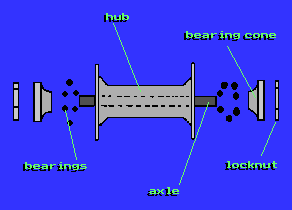
See also: Roller bearing, Needle bearing
Bike Bearing adjustment - See bearing cup for details.
Bike Bearing balls - Case-hardened steel balls used in bicycle bearings. These are very solid and precise, often with a precision to plus or minus two-millionths of an inch.
Bike Bearing cone - See bearing cup for details.
Bike Bearing cup - In all bicycles built until the last twenty years, and many built today, you'll find cone and cup bearings in the wheel hubs, bottom bracket, headset, pedals and sometimes other components. In a cone and cup bearing, a circle of bearing balls roll between a cup and a cone. The cone, or sometimes the cup, is mounted with screw threads on an axle or spindle, to control the tightness of the bearing. You don't want the adjustment too tight, or there will be friction, and rapid wear. On the other hand, if the bearing is loose, there will be wobbliness, friction and rapid wear also. In the case of wheel hubs, there are two bearing cups, one built into each side of the hub shell, and there are two cones, one on each side of the axle. Synonym: Ball cup.
Bike Bearing race - A hard surface in a ball or roller bearing against which the balls or rollers run. Bearing cones and cups are both races. See also: case-hardened.
Bellcrank - A linkage between a three-speed hub (made by Shimano) and the control cable. To adjust, look for a red line and circle on the lever inside which should exactly align with a slot and circle on the bellcrank housing when the shifter is in the second gear position.
See Also: Sturmey-Archer
Bendix - An American manufacturer of bicycle parts with facilities in Mexico. Bendix is most known for coaster brake hubs, and also manufactures automotive and home heating components.
Benelux - A company which used to make a conversion kit to put three sprockets on planetary gear set hubs (three-speeds) resulting in nine-speed bicycles.
Bent - Short for "recumbent." A bike that's built close to the ground for less wind resistance, and lower center of gravity.
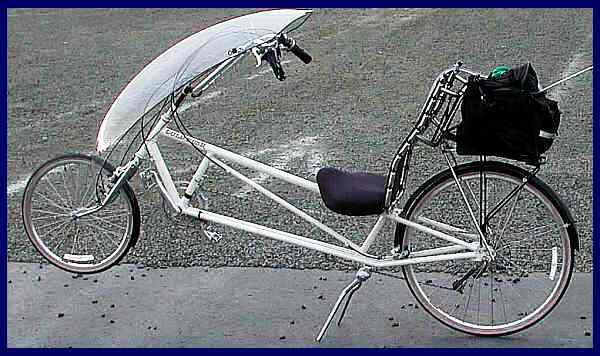
Bicycle Trailer - A device which follows behind a bicycle to carry cargo or children. See "Trailer" for more details.
See also: Make money building bicycle trailers.
Bike Stand - Synonyms : workstand, repair stand.
Blowout - You'll know a blowout when you hear one! There are two versions. The most common occurs at gas stations, where inexperienced bicyclists fill their tires with much more air pressure than the tires are designed to hold (don't trust those inflation systems which have a box on a post and a crank which you turn to dial the pressure you want), or fill tires which are not mounted correctly. The other variety occurs when you hit a stone, curb, or large puncturing object which damages the tire in a big way.
If the blowout has broken the steel cables within the edges of the tire (called "the bead") then there's nothing you can do other than replace the tire. If a small tear has been made in the tire, you can sometimes reinforce it by laying a bit of denim or similar material between the inner tube and the tire. This will keep the inner tube from expanding through the hole and blowing out again.
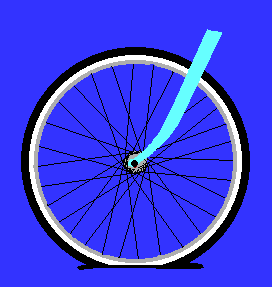
How-To: Fix a flat tire
BMX - Bicycle Motocross. 1. A form of competition patterned after off-road motorcycle competition called "motocross." BMX has taken on a life of its own far beyond motorcycle motocross. Most participants are children or teenagers. Larger kids and adults may use 24" wheels, but most competitors use 20" wheels. The BMX bicycle has fat tires, heavy-duty yet lightweight parts, and caliper or cantilever brakes and a single-speed freewheel. 2. A bicycle patterned after BMX racing bikes. Although they look similar to actual BMX racing bikes, most BMX bicycles never see competition except between brother and sister out in the driveway or backyard. Freestyle bikes (which see) are similar in appearance and made from many components that are interchangeable with BMX bikes, but are used for trick riding.
Bolt - A metal rod with threads that screw into a nut. Technically, if it screws into anything other than a nut, then it is called a "screw," but "bolt" and "screw" are generally used interchangeably. Bolts and nuts often trap two parts between them, such as a toeclip and a pedal. When used on bicycles, they usually have some system to keep them tightly together in a vibrating environment, such as lockwashers, or nylon friction-causing inserts.
Boneshaker - Synonyms: penny-farthing, ordinary.
Bottom bracket - The part of the bicycle frame which houses the crank bearing assembly; the bearing set in which the cranks rotate; Synonym: bottom bracket housing; bottom bracket bearings; bottom bracket set.
Bottom bracket housing - The part of the bicycle frame that houses the crank bearing assembly which is called the "bottom bracket set."
Bottom bracket set - The bearings, axle (called "spindle") and related hardware between the cranks in the bottom bracket housing.
Bottom bracket spindle - The axle upon which the cranks are mounted.

Box-end wrenches - Wrenches that have a ring with six or twelve points. The ring fits securely around a nut or bolt to turn it. Box end wrenches are slower to use than open-end wrenches, and cannot work where you have less than full access to the nut or bolt, but are more secure, and therefore good for use with tight nuts or bolts. See also Combination wrenches, Open-end wrenches, Socket sets.
Brake - A component of a bicycle designed for stopping. There are three types, caliper brakes, which rub small pads against the wheel rims to stop,
and hub brakes, which operate in or near the center of the bicycle wheels. The hub brakes are further divided into disk and internal brakes. Most of the internal brakes are coaster brakes that you turn the pedals backward a little bit to actuate. Hub brakes are known for more reliable stopping in wet weather. Coaster brakes are very low-maintenance and reliable. Caliper brakes tend to weigh less, and do not put as much stress on the spokes.
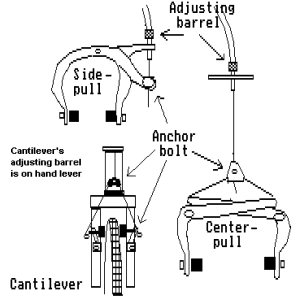
How-to: Service brakes
Brake arm - By pedaling backward about an eighth-turn of the pedals, a coaster brake can stop a bicycle's rear wheel easily. The torque developed at the hub is tremendous. Normally, that torque would spin the coaster brake's axle within the dropouts - not a desirable condition because it can damage the bike frame, or wreck the hub bearing adjustment. Therefore, to counteract the force, a steel arm comes out of the left side of the coaster brake, and is fastened to the chainstay a few inches away. This is the brake arm. Synonym: Reaction arm.
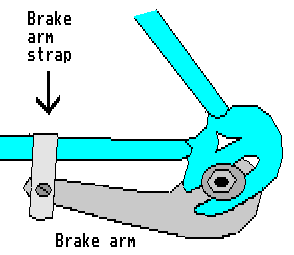
See also: Coaster brake
Brake arm strap - A metal bracket which ties the brake arm of a coaster brake to the chainstay. Some start out as a flat strap of sheet steel. You bend the brake arm strap around the chainstay, and then install a bolt, lockwasher and nut through holes in the brake arm strap and the brake arm.
Brake lever - The control on a handlebar for operating a brake. Synonym: Hand lever.
Brake pad - The portion of a caliper braking system which rubs against the rim when the hand levers are operated. Brake pads should provide lots of friction, without melting or wearing away in severe braking conditions. They should also work almost as well when wet as when dry. This is not always the case. On many lower-priced bicycles, the brake pads are a dangerous weak point, and should be replaced with higher-quality pads.
Most bicycles have a way to adjust the height of the brake pads. Many bicycles also have a way to adjust the angle of the pads. It is important to make sure the adjustment is correct and secure. If a brake fails, for instance if a brake pad slips under the inside edge of the rim, it tends to happen in a hard stop, when you need it most!
Brake post - The part of a bicycle frame or fork onto which cantilever brakes are mounted.
Brake quick release - A device which can take various forms. It is a system to allow brakes to open wider than normal so the wheels can be removed and installed. On some brakes, it is a straddle wire (short transverse cable) that can be lifted away from one side of the brake caliper. On others, it is a lever near the adjusting barrel or on a hand lever that can be flipped to allow the brake to open wider.
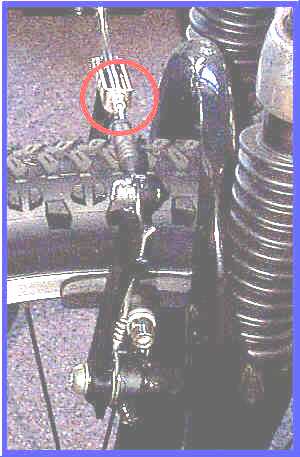
Brass - a coppery-golden colored metal that is nearly as strong as mild steel. Brass is seldom seen in bicycle parts, but is often used as a brazing material to join bike frames together, especially hand-built frames.
Brazing - A form of hot gluing which is similar to welding. The glue is brass which flows as a liquid at temperatures beyond 1600 degrees Fahrenheit. Brazing is strong enough to be used as a means of holding bicycle frames together. In fact bicycle frames that are brazed can be stronger than welded frames if done correctly. There are two types of brazing. In one, "lug brazing," steel lugs or plates are used to provide lots of surface area. The lugs or plates surround the items to be joined, and hot brass is flowed between the plates or lugs and frame tubes or other steel parts. The other, "fillet brazing" the fit of the parts is not critical, as long as they are in contact. First hot brass is flowed between the parts to tack them together. Then, by carefully controlling a torch flame and a brass rod, a bead of brass is laid around the intersection, much like applying caulking around a bathtub. The bead adds structural integrity. Some frame builders who use fillet brazing will then artistically file the beads until they blend smoothly into the frame tubing. Brazing is done with a standard oxy-acetylene or oxy-propane welding set. See also Welding, MIG welding, TIG welding, and Silver brazing.
Brinnell - An effect in which bearing balls create evenly spaced dents in the races in which they run. Brinnelling can be caused by a sudden impact, or long-term continuous wear. It is most often seen in the bottom race of headsets.
Bridge wire - A short cable wire which connects two sides of a cantilever or centerpull brake together, and to which the main brake cable is attached. Synonym: Straddle wire.
Bungee cord - An elastic strap with a hook at either end, most commonly used with luggage carrying platforms that mount over the rear wheel of the bicycle. Bungee cords are a bit dangerous if left loose on the rack. If one of the hooks falls into the rear wheel spokes, the rider is in for a surprise! Bungee cords may also be used when transporting bicycles on cars, to support the bike, or keep wheels from turning front wheels from flopping sideways. Synonym: Stretch cord.
Butted - A concept used mostly when talking about frame tubing or spokes. It turns out that long structural members of bicycles, as well as most other machines, require the greatest strength at their ends. Therefore, to save weight, expense or wind resistance, the middles of the structural members can be made thinner. Butted usually implies single-butted - thicker at only one end, but it is a generic term for single-butted or double-butted.
![]()
Anything missing or need greater coverage? Let me know - Jeff
Tell a Friend About BikeWebSite
Please feel free to link your web pages to www.bikewebsite.com.
Disclaimer
Although I have attempted to cover the major safety issues, I cannot be responsible for your use of this information. Working on bicycles is dangerous if you do it without considering consequences of bolts left loose, known problems which are ignored, things which should be replaced but are glued instead, and so on. Proceed carefully at your own risk and use common sense. Jeff Napier, and all agents associated with this information, do not offer any guarantee or warranty for your use of this information.
Copyright © 1991-2014, bikewebsite.com